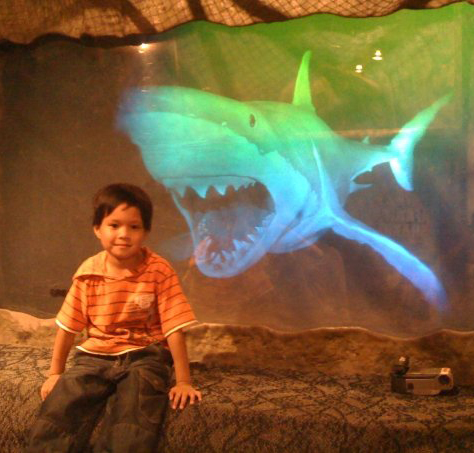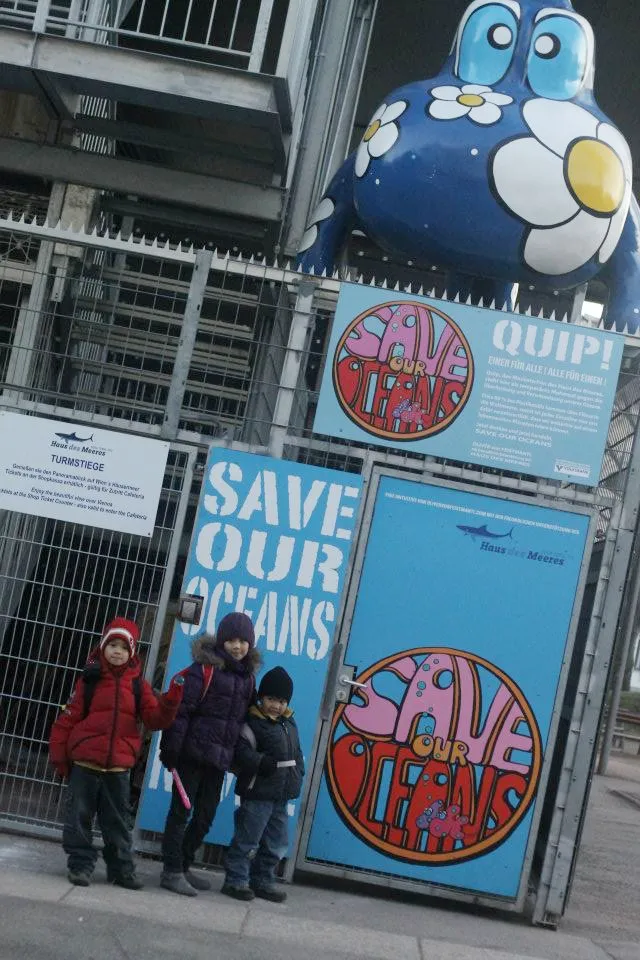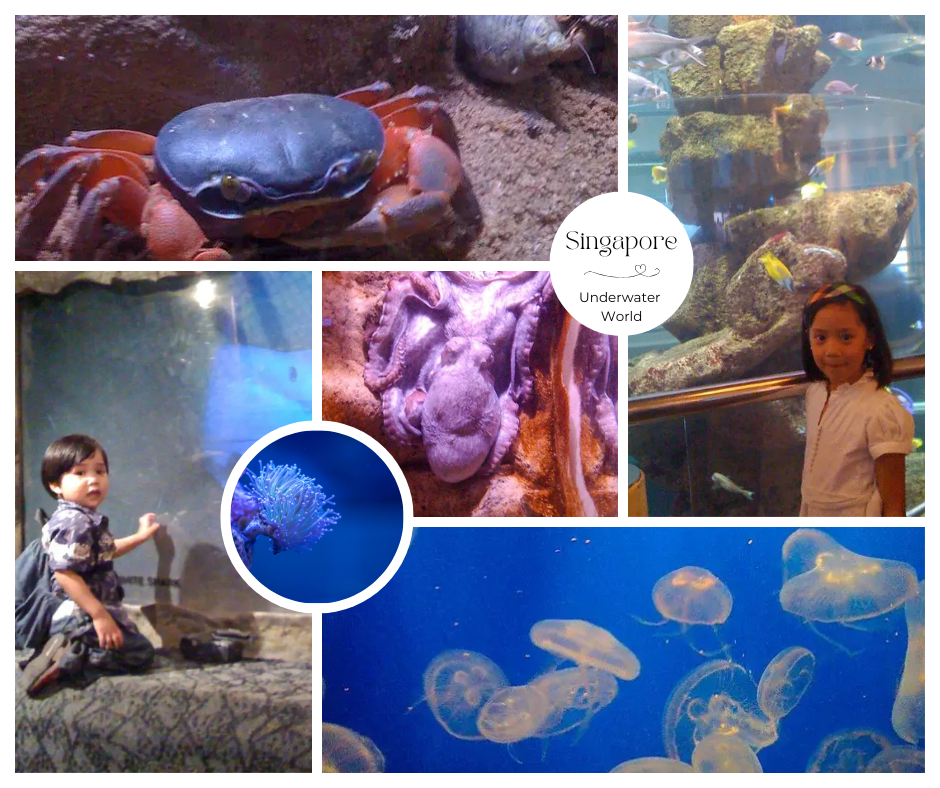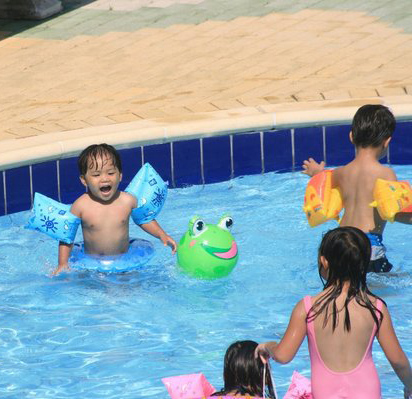
Fascinating Aquariums For Kids To See and Explore : Haus des Meeres (Dec 2011)
This post is updated whenever we visit a new aquarium.
There is no denying how much humans depend on the ocean. For one, the tiny, overlooked Phytoplankton helps us in a very essential way. They don’t only remove (consume) excess carbon dioxide, they release half of the earth’s oxygen in the atmosphere. Now, imagine what happens if they all die. Of course, it follows that everything else will die.
The ozone layer, or layers of oxygen [three oxygen atoms (O3)] will be depleted, causing high levels of ultraviolet light and heat from the burning sun to reach Earth and eventually destroy it.
That’s why we believe that teaching kids to be green is an important step to help better our practices to lower carbon footprint and to help save our oceans.
How do we make kids see that they are able to help save the oceans? Watching documentaries and educational materials for one will make them aware of the issues. Bringing them to the sea or any body of water for a dive will make them appreciate creation and make them curious. Participating in cleanup drives on the beach will also make them see that even little actions reap big results.
If the beach is too far off, going to aquariums (public aquariums, oceanariums, marine mammal parks, and dolphinariums) to observe sea life and listen to lectures is one way for them to see the impact of ocean conservation. Also, having an aquarium at home will make them see that not cleaning it up is detrimental to its inhabitants.

Aquariums For Kids To See and Explore : 3D shark
Table of Contents
Benefits of Aquariums to Children
Aquariums can offer numerous benefits to children, promoting their education, well-being, and overall development. Here are some of the benefits of aquariums to children:
Educational value
Aquariums provide a hands-on learning experience for children. They can observe and learn about various marine life, such as fish, corals, and invertebrates. Children can develop an understanding of different species, their behaviors, habitats, and ecosystems. This knowledge can foster a curiosity for science and the natural world.
Relaxation and stress reduction
Watching fish swim in an aquarium can have a calming effect on children. The peaceful and serene environment created by the underwater world can help reduce stress, anxiety, and promote relaxation. It can serve as a therapeutic and comforting experience, especially for children with special needs or those who find it difficult to unwind.
Sensory stimulation
Aquariums provide visual stimulation with bright colors, movement, and the play of light through the water. Children can engage their senses by observing the fish and other aquatic creatures. The gentle bubbling sound of the water can also provide auditory stimulation.

Fascinating Aquariums For Kids To See and Explore : Save Our Oceans
Responsibility and empathy
Taking care of an aquarium can teach children about responsibility and empathy towards living beings. They learn to feed the fish, maintain water quality, and ensure the overall well-being of the aquatic environment. This sense of responsibility can extend to other aspects of their lives as well.
Therapeutic benefits
Some studies suggest that aquariums can have therapeutic benefits for children. The presence of an aquarium in settings like hospitals or therapy centers can help reduce pain perception, lower blood pressure, and enhance overall well-being. Additionally, caring for an aquarium can provide a sense of purpose and accomplishment.
Imagination and creativity
The underwater world of an aquarium can spark a child’s imagination and creativity. They may create stories or artwork inspired by the marine life they observe. This imaginative play can enhance cognitive development and encourage self-expression.
Social interaction and communication
Aquariums can serve as conversation starters and encourage social interaction. Children can share their observations, facts, and experiences with peers, siblings, and adults. This can foster communication skills, teamwork, and cooperation.
Environmental awareness
Through aquariums, children can develop an appreciation for the environment and its preservation. They learn about the importance of conservation, sustainable practices, and the impact of human activities on marine ecosystems. This understanding can instill a sense of responsibility towards the environment from an early age.
Upclose Safely
Aquariums give children a good view of the underwater world without the risks involved of being actually in water.
Berlin Aquadom and Sea Life

The Aquadom opened in December 2, 2003. It is located inside the Radisson Blu (edit: rebranded to Radisson Collection Hotel) in the middle of Berlin, surrounding a transparent elevator where you can view, more or less, 1,500 saltwater fish. The 82ft-tall cylindrical aquarium is said to be the biggest in the world, and the only one with an elevator. It holds the Guinness World record for being the tallest aquarium to contain an elevator in the middle.
This is of course just one of the attractions of the Berlin Sea Life Centre. The Aquadom leads to the entrance of the Sea Life Centre which holds another 5000 species of marine creatures in pools and domes replicating their own homes.
The center showcases fish from tropical coral reef – clownfish, surgeonfish, and those from depths of the atlantic ocean – atlantic wreckfish, stingrays, houndsharks among other deepwater creatures.
Other inhabitants in the center that we are most familiar with include octopus, seahorses, jellyfish, sea robins/gurnard, and sharks.
There is a touchpool where kids can touch starfish, corals and other safe creatures.
There are talks/lectures the kids can listen in to. There are also feeding demonstrations throughout the day where kids can watch, not only those in the pool but those in the dome too.
Updates:
December 2022 : The Aquadom burst…. ![]()
![]()
![]() Despite it being more than 20cm thick.
Despite it being more than 20cm thick. ![]()
![]() Two persons were injured during the blast…A spokesman for Berlin’s fire brigade said majority of the fish had died, and the cold weather had made rescue attempts more difficult. The tank had contained more than 100 different species.
Two persons were injured during the blast…A spokesman for Berlin’s fire brigade said majority of the fish had died, and the cold weather had made rescue attempts more difficult. The tank had contained more than 100 different species. ![]()

Fascinating Aquariums For Kids To See and Explore : Starfish in the Touchpool at Berlin Sea Life Centre (April 2014)
Haus des Meeres, Vienna
Haus des Meeres translates to House of the Sea but when the kids hear this, they immediately know that it’s an ocean park in a tall building, 10 floors to be exact. The 11th floor, is a flat roof with some benches and functioning telescopes, so you can get a good view of Vienna’s skyline.
Each floor has a different environment replicated for its inhabitants. There are tanks for tropical fish and sea animals, for mediterranean fish, for local freshwater fish, for sharks, and for Puppi, the turtle that was saved from a market that brought about the expansion of the Haus des Meeres.
There’s also a crocodile park, which is visible from the glass ceiling once you enter the premises. Most interestingly is the open tank where you can touch large, friendly, colorful kois.

You need to allot at least 3 hours when visiting the Haus des Meeres, but half a day or more is alright too.
Updates:
July 2019: The 360° Ocean Sky (rooftop café) has been opened to all. It used to be accessible only to those visiting the aquarium.
September 2013 : The renovation of the roof deck was finished. They’ve installed a 1.5 m high glass barrier with a total area of almost 260 m2 round the new viewing terrace that offers a fantastic all-round view of Vienna. In the center of the rooftop is a glass house of over 200 m2, which serves as a café and probably a function room.
June 2013: Tower Museum opened. A hall that used to be a 1.90 meter high storage room has been turned into a museum.
Vienna’s Schönbrunn Aquarium and Terrarium House
Schönbrunn Zoo is one of the oldest and most renowned zoos in the world, and it primarily focuses on housing and displaying a wide variety of terrestrial animals. The Schönbrunn Zoo Aquarium and Terraium house gives visitors a glimpse into the diverse aquatic and reptilian life from around the world. Situated within the historic Schönbrunn zoo, this attraction is known for its well-maintained exhibits and educational value.

Key Features
Aquarium Section:
Marine and Freshwater Habitats: The aquarium houses a variety of tanks that replicate different aquatic environments, from tropical coral reefs to freshwater rivers and lakes.
Species Diversity: Visitors can see a wide range of fish, including colorful reef fish, sharks, rays, and various freshwater species. The exhibits often include species-specific information and conservation statuses.
Interactive Displays: Many tanks feature interactive elements, such as touch screens and information boards, providing insights into the behaviors, diets, and habitats of the aquatic life on display.
Terrarium Section:
Reptiles and Amphibians: This section showcases a variety of reptiles and amphibians, including snakes, lizards, frogs, and turtles. The enclosures are designed to mimic the natural habitats of the species they contain.
Invertebrates: There are also exhibits featuring invertebrates such as spiders and insects, highlighting the diversity and ecological importance of these creatures.
Educational Focus: The terrarium section emphasizes the ecological roles of reptiles and amphibians, their adaptations, and the conservation efforts needed to protect these often-threatened species.
Themed Exhibits:
Rainforest and Desert Zones: Themed areas within the house create immersive experiences that mimic rainforest and desert environments, providing appropriate climates for the species housed within.
Coral Reef Tanks: These large, lively tanks are particularly popular, showcasing the beauty and complexity of coral ecosystems and the myriad species that inhabit them.
Conservation and Research:
Breeding Programs: The aquarium and terrarium participate in breeding programs for endangered species, contributing to global conservation efforts.
Research and Education: Collaborations with scientific institutions help further research on species conservation, behavior, and habitat preservation. Educational programs and workshops are frequently offered to engage visitors of all ages.
Visitor Experience
Guided Tours and Talks: Regularly scheduled tours and educational talks by knowledgeable staff provide deeper insights into the exhibits and the species housed within.
Family-Friendly: The aquarium and terrarium are designed to be engaging for visitors of all ages, with interactive displays and child-friendly information.
Accessibility: The facilities are accessible to visitors with disabilities, ensuring a comfortable and educational experience for all.
The Schönbrunn Aquarium and Terrarium House thus serves as a vital component of the Schönbrunn Zoo, combining entertainment with education and conservation, and offering a window into the fascinating worlds of aquatic and terrestrial life.
Singapore Underwater World
The Singapore Underwater World opened in May 13, 1991 in Sentosa, Singapore. As hubby visits Singapore often during his childhood, this was one of his favorite places to see. On our brief visit to Singapore, he made sure that the kids get to see the place that’s also favorite childhood memory.
The Singapore Underwater World feature a vast oceanarium that allowed visitors to explore an array of marine life in a walk-through tunnel. The oceanarium was mostly underground and has a travelator/moving walkway that made it easy for visitors to move around and see marine creatures from the windowed-tunnel. Visitors could observe various aquatic creatures, including sharks, rays, colorful fish, and other marine species. The attraction aimed to provide an educational and immersive experience by showcasing different underwater environments and raising awareness about marine conservation.

Some of the notable creatures that were present at the attraction included:
- Sharks: Visitors could observe various shark species, including blacktip reef sharks, nurse sharks, leopard sharks, and sandbar sharks. These majestic creatures were often a highlight of the aquarium.
- Rays: The Singapore Underwater World featured different species of rays, such as the Southern stingray, cow-nosed ray, and leopard whipray. Visitors could witness their graceful movements as they glided through the water.
- Fish: The attraction housed a wide range of colorful and diverse fish species. This included tropical fish like angelfish, clownfish (popularly known as Nemo), tangs, butterflyfish, and triggerfish.
- Turtles: Visitors had the opportunity to observe turtles at the Singapore Underwater World. Species such as the green sea turtle and hawksbill turtle were present, allowing visitors to learn about these endangered creatures and the conservation efforts to protect them.
- Marine Invertebrates: The aquarium also featured various fascinating marine invertebrates, such as corals, sea anemones, sea stars, and sea cucumbers. These creatures added to the overall diversity and ecological representation of the underwater world.
- Other Marine Life: Additionally, the Singapore Underwater World showcased other marine life forms, including jellyfish, seahorses, moray eels, and various species of crustaceans.
Update:
Singapore Underwater World closed on June 26, 2016 – it operated for (+1 month shy of) 25 years. We’re glad the kids were able to experience the Singapore Underwater World before it closed down.

Fascinating Aquariums For Kids To See and Explore : Singapore Underwater World (June 2009)
Dolphin Lagoon, Sentosa
Dolphin Lagoon Sentosa is an attraction located on Sentosa Island in Singapore. It offers visitors the opportunity to observe and interact with dolphins in a controlled and educational environment.
Location: Dolphin Lagoon Sentosa is situated on Sentosa Island, a popular resort island located off the southern coast of Singapore. It is easily accessible by various transportation options, including cable car, shuttle bus, and monorail.
Dolphin Shows: One of the main attractions at Dolphin Lagoon Sentosa is the dolphin shows. Trained dolphins perform a variety of tricks and stunts, showcasing their agility, intelligence, and natural behaviors. Visitors can witness the dolphins’ grace and enjoy their playful interactions with their trainers.
Dolphin Lagoon, Nuremberg Zoo
The dolphin exhibit at Nuremberg Zoo is known as “Delphinarium” and is one of the main attractions within the zoo. Here are some key details about the dolphin exhibit:
- Dolphin Shows: The Delphinarium offers scheduled dolphin shows where trained dolphins showcase their agility, intelligence, and natural behaviors. Visitors can witness the dolphins performing various tricks, jumps, and synchronized movements under the guidance of experienced trainers.
- Educational Presentations: Along with the shows, the Delphinarium provides educational presentations to educate visitors about dolphins and their natural history. Knowledgeable trainers share information about dolphin behavior, biology, conservation, and the importance of protecting marine ecosystems.
- Dolphin Interaction Programs: Some dolphin exhibits may offer interactive programs where visitors can engage in dolphin encounters. These programs may include opportunities for visitors to touch, feed, or swim with dolphins under the supervision of trained professionals. Such programs provide a more immersive experience and allow visitors to learn about dolphins up close.
- Conservation and Research: The Delphinarium at Nuremberg Zoo likely emphasizes the importance of conservation and participates in research initiatives to further our understanding of these marine mammals. They may be involved in conservation projects, such as breeding programs, to contribute to the conservation of dolphins and their habitats.

Fascinating Aquariums For Kids To See and Explore : Dolphinarium, Nuremberg (2005)





